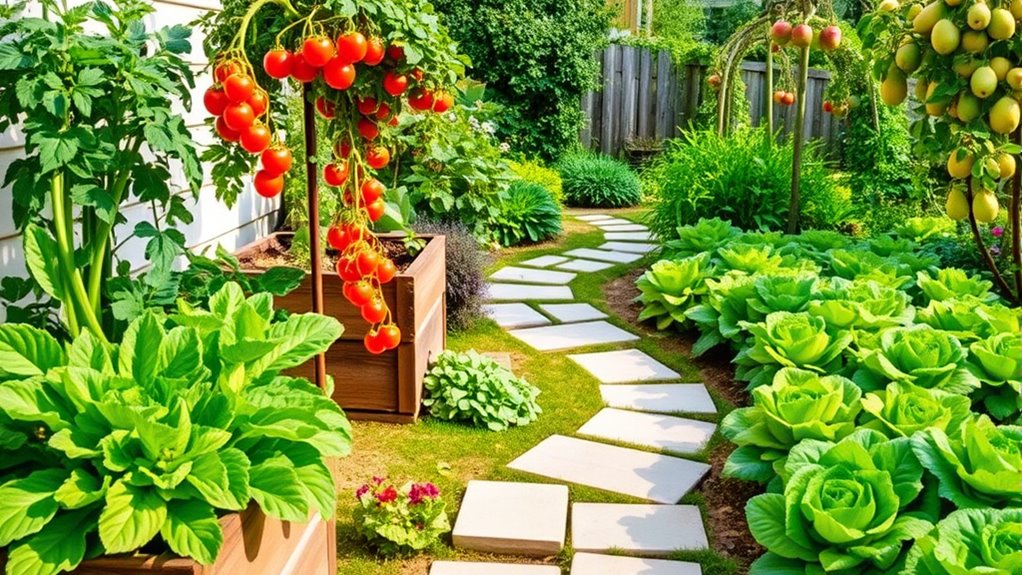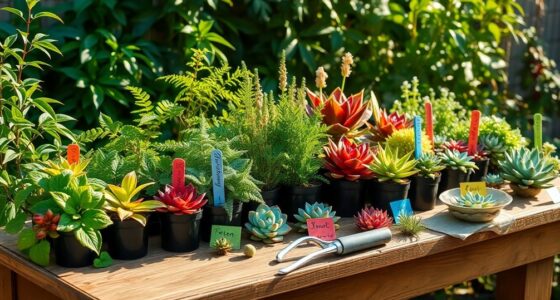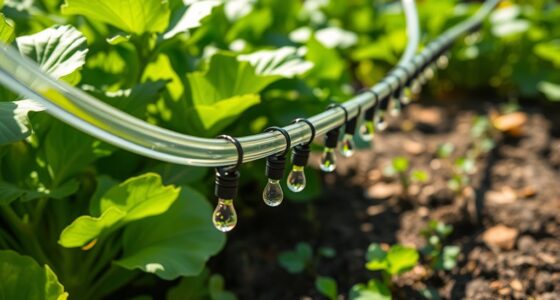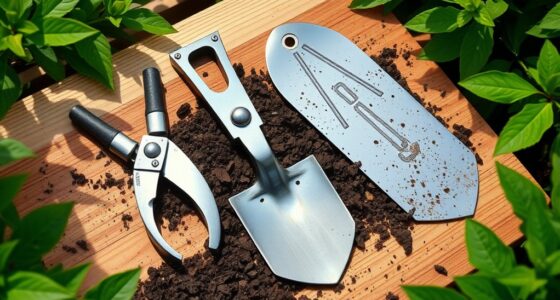Edible landscaping that looks great combines vibrant flowers, colorful vegetables, and ornamental plants for a balanced, eye-catching garden. You can place fragrant herbs and flowering edibles like nasturtiums and marigolds near pathways, incorporate vertical gardens to maximize small spaces, and use perennial plants for ongoing interest. Mixing ornamentals with edibles adds texture and color, all while supporting your climate and soil. Keep exploring; you’ll find more tips to create a stunning, productive outdoor space.
Key Takeaways
- Combine colorful edible flowers and vibrant vegetables for visual appeal and culinary flavor.
- Design layered layouts with ornamental plants, herbs, and edible crops for aesthetic harmony and functionality.
- Use vertical gardens and compact planting techniques to maximize space and create eye-catching displays.
- Incorporate fragrant and ornamental perennials for year-round interest and low-maintenance beauty.
- Strategically position edible plants along pathways and borders to enhance landscape design and accessibility.
Incorporating Edible Flowers for Color and Flavor

Adding edible flowers to your landscape not only boosts its visual appeal but also enhances the flavor of your dishes. You can use them strategically for companion planting, which helps improve pest management by attracting beneficial insects and repelling harmful pests. For example, marigolds planted near vegetables can deter nematodes, while nasturtiums attract aphids away from your crops. Incorporating a variety of edible flowers like pansies, calendulas, and violas adds vibrant color and subtle flavors to salads, desserts, and drinks. Their presence creates a natural, eco-friendly pest control system that reduces the need for chemicals. Additionally, understanding zodiac compatibility can inspire harmonious garden layouts that attract beneficial insects and promote plant health. By thoughtfully integrating edible flowers into your landscape, you enjoy aesthetic beauty, a flavorful harvest, and a healthier garden environment.
Designing With Fruit-Bearing Trees and Shrubs
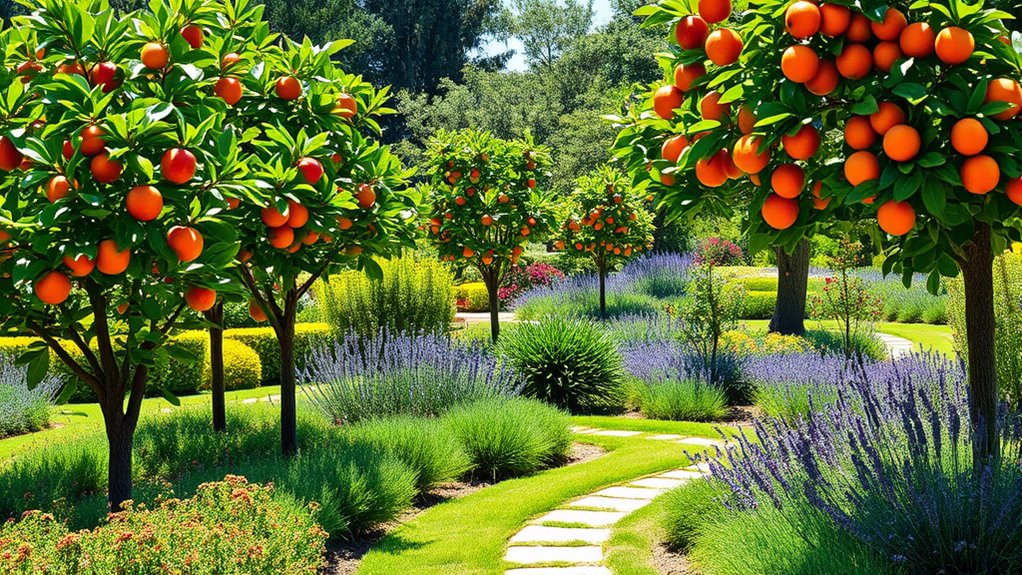
When designing with fruit-bearing trees and shrubs, consider their placement to maximize both beauty and harvest. You can blend edible plants with ornamentals to create a harmonious landscape that’s both functional and attractive. Thinking about how these plants interact will help you craft a space that’s inviting and productive. Incorporating garden layout principles can further enhance the overall aesthetic and efficiency of your edible landscape.
Aesthetic Tree Placement
Strategic placement of fruit-bearing trees and shrubs enhances both the beauty and productivity of your landscape. Position taller trees near garden pathways to create natural shade and structure, while shorter shrubs can fill in gaps and add layers. Consider spacing trees so their canopies don’t overpower each other, maintaining visual balance. Proper placement also attracts wildlife habitats, encouraging beneficial insects and birds that support your garden’s health. Keep fruit trees away from walkways to prevent falling fruit from creating hazards. Grouping similar species together creates a cohesive look and simplifies harvesting. Use aesthetic considerations like symmetry or asymmetry to achieve your desired style. Thoughtful placement ensures your edible landscape is both visually appealing and ecologically supportive, making your yard a thriving, beautiful space. Self Watering Plant Pots can be an excellent tool to help maintain the proper moisture levels for your trees and shrubs, reducing the need for frequent watering and promoting healthy growth.
Combining Edibles and Ornamentals
Integrating edible plants with ornamental landscaping creates a vibrant, functional space that delights the eye and nourishes the body. To achieve this, position fruit-bearing trees and shrubs along garden pathways, making them accessible yet visually appealing. Use strategic watering techniques, such as deep watering at the base, to keep both ornamentals and edibles healthy without overwatering. Mixing edibles with ornamentals adds texture and seasonal interest, so choose plants that complement each other in height, color, and form. Incorporate different planting layers to maximize space and create a seamless flow. This approach not only enhances your landscape’s beauty but also ensures your edible plants thrive, providing fresh produce right outside your door. Balancing aesthetics with functionality creates a truly inviting edible landscape.
Using Edible Perennials to Ensure Year-Round Interest
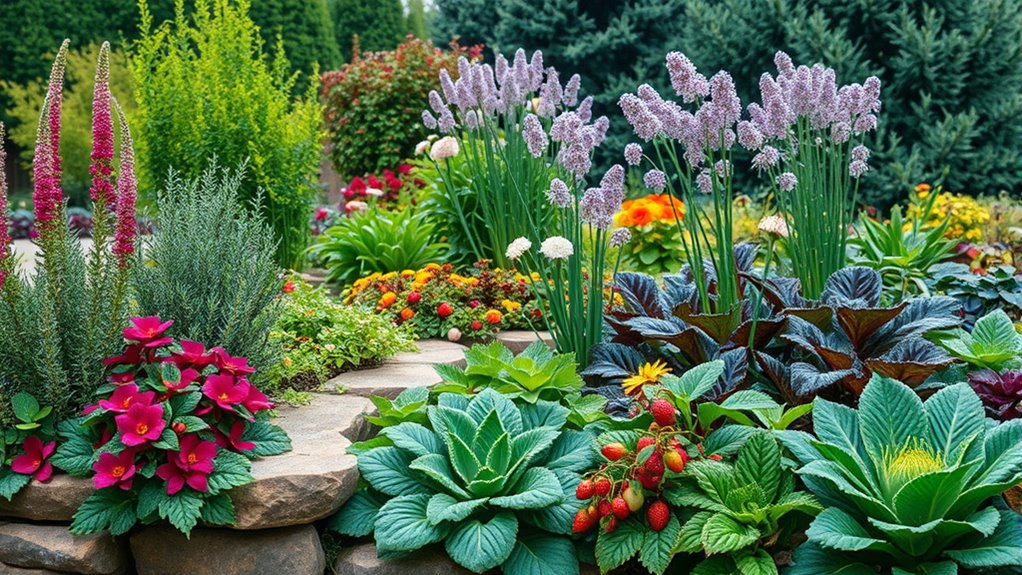
Using edible perennials can keep your landscape vibrant throughout the year, thanks to their seasonal color changes. Many of these plants require minimal upkeep, making them ideal for low-maintenance gardens. By choosing the right varieties, you can enjoy continuous interest without extra effort. Incorporating greenhouse techniques can further extend the growing season and protect your edible perennials during harsh weather conditions.
Seasonal Color Variations
By selecting edible perennials with varying bloom times, you can create a landscape that offers vibrant color throughout the year. This approach keeps your garden visually appealing and productive across seasons. To maximize color, regularly practice plant pruning to encourage healthy growth and more blooms. Keeping pests at bay through effective pest management ensures your plants stay vigorous and vibrant. Consider including perennials that bloom in different seasons, such as rhubarb in spring, chives in summer, and kale in fall. This diversity provides continuous visual interest and harvests. It also reduces the risk of losing all color at once. Planning with seasonal variation in mind helps you enjoy a dynamic, edible landscape that’s both beautiful and functional year-round. Understanding cookies can help you manage your website preferences more effectively.
Low Maintenance Choices
Choosing low-maintenance edible perennials is a smart way to guarantee your garden stays vibrant and productive year-round without demanding constant effort. These plants typically resist garden pests better than annuals, reducing the need for frequent interventions. To succeed, start with proper soil preparation—enrich your soil with compost to improve drainage and nutrients, creating an ideal environment for perennials to thrive. Once established, these plants require minimal watering and care, saving you time and energy. Select hardy varieties suited to your climate, such as rhubarb, asparagus, or chives, which return each season with little fuss. By focusing on low-maintenance options, you’ll enjoy fresh produce and lush greenery without the hassle of intensive upkeep.
Creating Vertical Gardens for Small Spaces

Ever wondered how to maximize limited space while growing your own food? Creating vertical gardens is a smart solution. They allow you to grow herbs, vegetables, and even small fruits in tight spots like balconies or narrow yards. To guarantee success, consider companion planting—pairing plants that support each other, like basil with tomatoes to enhance flavor and deter pests. Vertical setupssalso help with pest control by keeping plants off the ground and reducing exposure to soil-borne issues. Use sturdy wall mounts, trellises, or pocket planters to efficiently utilize vertical space. Remember, a well-designed vertical garden isn’t just functional; it adds visual appeal to your landscape. With the right planning, you’ll enjoy fresh produce without sacrificing precious space. Additionally, store hours can vary by location, so planning your visits accordingly can ensure you get the supplies you need for your garden.
Combining Ornamental and Edible Plants for Visual Harmony
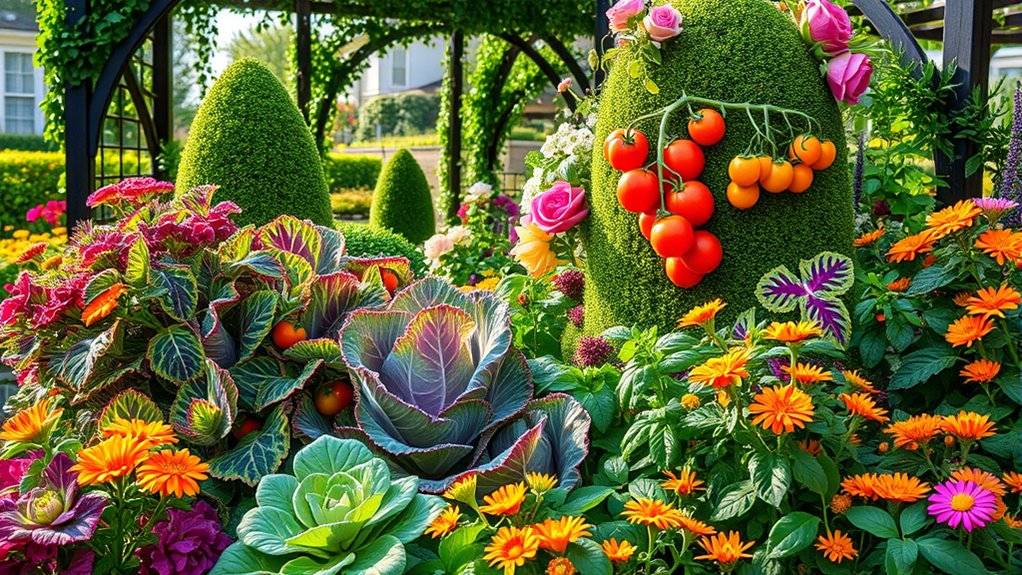
Integrating ornamental plants with edible ones transforms functional gardens into stunning visual displays. To achieve harmony, think about plant combinations that complement each other’s colors, textures, and heights. Use garden art and landscape lighting to highlight key features and create ambiance after dark. Mixing flowering herbs with vibrant vegetables adds visual interest, while layering tall plants behind shorter ones enhances depth. Here’s a simple guide:
| Ornamental Plant | Edible Plant | Placement Tip |
|---|---|---|
| Lavender | Blueberry bushes | Edges, for fragrance |
| Ornamental Kale | Cherry tomatoes | Center, for color contrast |
| Decorative Grasses | Pepper plants | Background, for movement |
This approach guarantees your garden is both functional and beautiful, inviting enjoyment day and night. Additionally, selecting pimple patches that are suitable for your skin type can help maintain a healthy, blemish-free appearance in your garden photos or outdoor settings.
Selecting the Right Plants for Your Climate and Soil
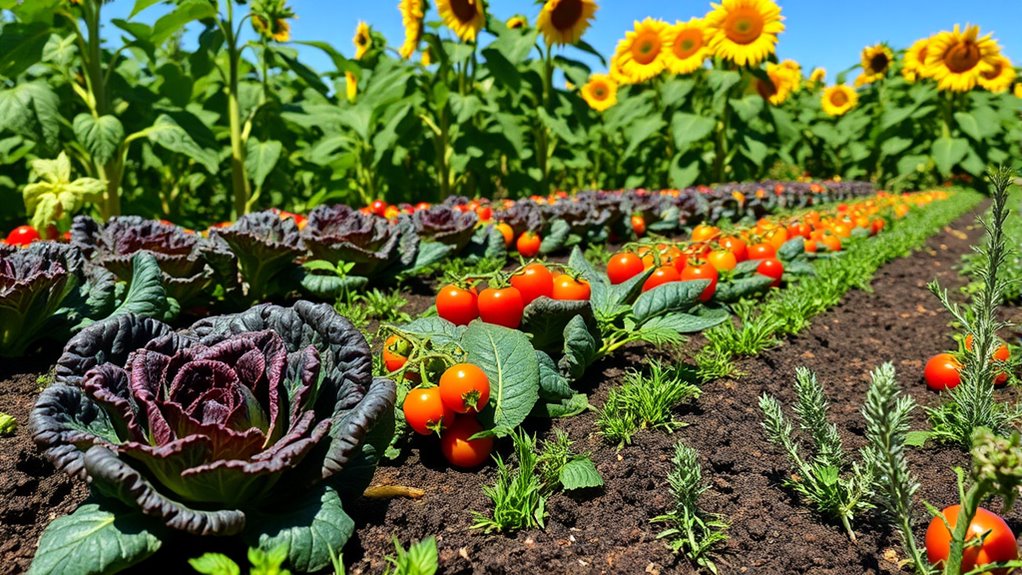
To create a thriving edible landscape, you need to select plants that are well-suited to your specific climate and soil conditions. Understanding your local weather patterns and soil type helps you choose varieties that will flourish naturally. Incorporate effective composting techniques to enrich your soil, promoting healthy growth without over-relying on chemical fertilizers. Proper pest management is also essential; selecting pest-resistant plants and practicing companion planting can reduce issues organically. When choosing plants, consider their sunlight, water needs, and tolerance to local conditions. This ensures your garden remains resilient and productive. Remember, tailored plant selection minimizes maintenance and maximizes yields, turning your landscape into a sustainable, beautiful food source. Additionally, being aware of plant health issues such as pests and diseases allows for timely intervention, ensuring a healthy and productive garden.
Frequently Asked Questions
How Can I Prevent Pests From Damaging My Edible Landscape?
To prevent pests from damaging your edible landscape, you should start with companion planting, which naturally deters pests by pairing plants that repel each other’s pests. Additionally, use natural repellents like neem oil or garlic spray to keep insects away without chemicals. Regularly inspect your plants, remove affected areas, and encourage beneficial insects like ladybugs to help control pest populations, ensuring a healthy, thriving garden.
What Are the Best Practices for Sustainable Edible Landscaping?
Think of your garden as a symphony, where every note counts. To keep it sustainable, you should practice companion planting, pairing plants that support each other’s growth and repel pests. Use mulching techniques to conserve moisture, suppress weeds, and enrich the soil naturally. These practices create a balanced ecosystem, reducing the need for chemical interventions and ensuring your edible landscape thrives for years to come.
How Do I Maintain Soil Fertility Naturally in Edible Gardens?
To maintain soil fertility naturally, you should use composting techniques regularly to enrich your soil with organic matter. Incorporate cover crop selection wisely; choose plants like clover or vetch that fix nitrogen and improve soil health. Rotate crops to prevent depletion and pests. Mulch around plants to retain moisture and add organic debris. These practices keep your soil vibrant, productive, and sustainable without synthetic fertilizers.
Can Edible Landscaping Be Safely Integrated With Native Plants?
You can safely integrate edible landscaping with native plants by focusing on native plant compatibility and edible native integration. Choose edible plants that naturally thrive in your region, ensuring they won’t disrupt local ecosystems. Plant them alongside native species with similar soil and sunlight needs, and avoid invasive varieties. This approach promotes biodiversity, supports local wildlife, and creates a harmonious, sustainable landscape that’s both functional and beautiful.
What Are Some Cost-Effective Ways to Start an Edible Landscape?
To start an edible landscape cost-effectively, you can use companion planting to maximize space and improve plant health without extra costs. Additionally, harvesting rainwater helps reduce water bills and supplies your plants sustainably. Start small with easy-to-grow herbs or vegetables, then expand as you learn and save. These strategies make your edible landscape affordable and eco-friendly, ensuring you enjoy fresh produce without breaking the bank.
Conclusion
Your garden is more than just a space; it’s a canvas where edible flowers and fruit-bearing plants paint a vibrant story of abundance. By thoughtfully blending ornamentals with edibles, you create a living mosaic that nourishes both body and soul. Think of your garden as a symbol of harmony—where beauty and practicality grow side by side, reminding you that with care, nature’s bounty can be both stunning and sustaining.
